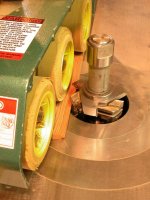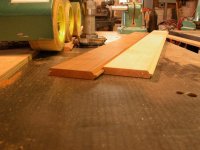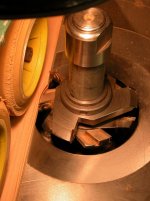I've ground hundreds of knives over the years, and made dozens of cutterbodies if including things like drilling tools, as well as shaping and planer types. The reason is as stated earlier, when i started the stuff just was not available, certainly not at anything like economical costs. I often did research before building - makes perfect business sense. Then figured how long and how much better i could build compared to a custom from someone like Yates-American, and made the decision.
I doubt 15% (just picking a wild number, but certainly less than 1 in 5 (20%) of the tooling or profiles was ever available off the shelf. I do buy conventional shapes when the cutting angles and geometry match what i need. Also modify off the shelf tools when faster/easier. But most tooling for most of my projects is just faster, cheaper, and more effective to build here.
The corrugated cutter MTP vise grip style heads shown above are an example of the process, ca 1985 or so. We were somewhat routinely making short runs of wide board flooring in various species, though mostly w. oak. You have to go back to the late 70's/early 80's for this to make sense - there were not commercial regular options for stuff like this, or more accurately, a whole bunch of us small shops throughout the US were just starting to meet a design driven demand for a "new" old look. During this period, there was very little choice in wood flooring, w. oak, r. oak, some maple for bowling alleys and rare residential, that was about it that was not custom from a small shop. your choices in the above were 2-1/4" strip, and 3-1/4" strip. There were several grades in each, and you could get QS in W.oak. "Clear" grade w.oak was about 50cents sf; "clear QS" was a couple cents more. (This was an era of quite a range of prefinished floors, though). This is too explain why we (& many others) were making flooring at the time. Sometimes we would re-machine factory strip for things like square parquet, or herringbone - sometimes it was just faster to make it all from scratch to reduce the waste of throwing out a lot of not-so-short ends from factory random bundles.
Getting back to the cutterheads - the only profiles available were for conventional strip, which had a very short, round tongue. When used on wider boards in the mid-Atlantic states climate, the tongues would pop over a seasons's cycle and begin to push the floor apart. My solution was a parallel sides tongue, a bit longer and narrower. YA priced them at several $1,000 dollars. I built my own in a few days. Thjey work fine, though the parallel feature does not really have adequate clearance angle. This was acceptable given the few hundred ft at a time we briefly made. It can be seen the heads are adjustable for fit (offset bits). If we had continued to make the product, i would have added a feature (re-machine parts of the heads to include stellite spurs). But shortly after, larger companies became more prevalent in the market and it became rarer that it made sense for us to run the product. I also always, even from the first requests, had a philosophical problem with the concept of T & G (or spline) wide board flooring. Except in museums with back-up systems for never fail controlled humidity, very wide stuff is going to have wide cracks at some times of the year, and be tight at others. T & G weakens the edge over the groove, and makes the life of the floor dependent on that thin-ness. IMO, if you want the look of wide voard floors, better to square edge on a very sound subfloor system, adhere with modern urethane flooring adhesive, and screw & plug. The cracks will be no more or less, but the durability of the edges will be better. If the screws and plugs are uniformly set low enough, this will promote a longer life, and the floor won't fail when the edges over grooves have reduced a mere 1/8" or 3/16".
Anyway, the cutterheads made perfect practical and economic sense at the time, but times change, often suddenly and rapidly.
Many other cutterheads and tooling sytstems here have had much longer runs, and making them was usually very economically viable.
One defect that the "Euro" heads share with a range of simple planer style cutterheads for any sort of complex cut or production runs, is that the cut is all on one face of one bit. There are 2 problems. The primary problem is generally poor cutting geometry in some parts, no or impractical adjustability, and all the cut taking place on one face. The second problem is little option to sharpen the profiles without a complete re-grind. Systems such as the one below are available at the industrial level, but often it is economical to "Just build it". They work so much better. Insert cutterheads are failry fast and easy, especially if cutters are made in multiples while the machinery is set up.
Besides the much better cutting geometry, stacks like this will do a range of thicknesses with proportional T & G features, and the easy option to change overall proportions of a profile such as vertical location of T & G independent of depth of face, depth of bevel, etc.
smt


 (1-1/8" bore for scale)
(1-1/8" bore for scale)






